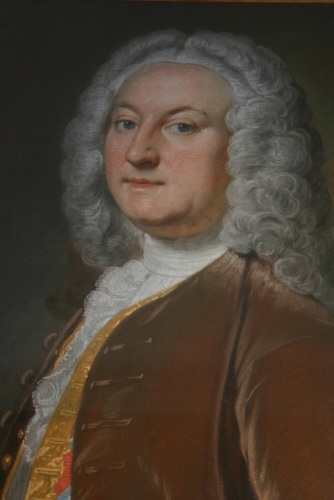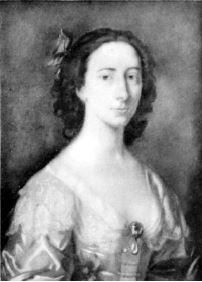This week our research volunteer Annemarie Powell takes a close look at our pastel portrait of Johnson’s childhood mentor.
 Here we are presented with a worthy eighteenth century gentleman of some comfortable means. His expression seems to exude the confidence of a man secure in his place in society.
Here we are presented with a worthy eighteenth century gentleman of some comfortable means. His expression seems to exude the confidence of a man secure in his place in society.
His body turned slightly to the left, Gilbert Walmsley looks out at us confidently. His features, somewhat angular, are softened by a gentle corpulence; his complexion is fresh and healthy. He is clean shaven and appears to be wearing a shorter full-bottomed wig. He is conservatively dressed in a fine collarless brown velvet coat with buttons which are not visible though the buttonholes are. Often these were sham except for three or four at the waist so that the frills and waistcoat could be displayed. Indeed, a fine cravat probably of lawn linen or muslin, the falling edge decorated with lace, graces the sitter’s neck. He sports a very splendid waistcoat or vent which seems elegantly embroidered in gold and blue. A lively face, Gilbert seems just on the edge of conversation.
Gilbert Walmsley was a man of law. In 1707 he was called to the bar after which he became registrar of the ecclesiastical court of Lichfield. For thirty y ears he lived in the Bishop’s Palace on the Cathedral Close and from this place of importance he opened his door to the young and talented of the area. Two of his most famous proteges were Samuel Johnson and David Garrick.
ears he lived in the Bishop’s Palace on the Cathedral Close and from this place of importance he opened his door to the young and talented of the area. Two of his most famous proteges were Samuel Johnson and David Garrick.
In 1736 Walmsley married Magdalen, also known as Margaret or Margery, Aston. She was the fourth daughter of eight of Sir Thomas Aston of Aston-by-Sutton, Cheshire. Two of Magdalen’s sisters seem to have taken the limelight: Mary or Molly Aston was much admired by Johnson for her wit and beauty as was her sister Elizabeth, although in an interview with Anna Seward years later his admiration seems tempered by criticism of her sharp temper. And here we begin to have some insight into Gilbert’s private life. Gilbert himself is described by Johnson as:
‘irritable and violent. But Walmsley was a man; and there is no man who can resist the repeated attacks of a furious woman. Walmsley had no alternative but to submit, or turn her out of doors.’
So this household was one of interesting tensions? Later, Gilbert left money to his sister-in- law in his will and both Magdalen and her sister Elizabeth, who had remained unmarried, were buried with him in Lichfield Cathedral.
Walmsley was described as ‘a most able scholar and the finest gentleman’ (Anna Seward) who was induced by school boy Johnson’s talent in classics ‘to endure, at his elegant table, the low born squalid youth, here that he suffered him and Garrick… a delighted spectator and auditor of their efforts.’
To help establish Johnson in a career suitable to his talents, Walmsley encouraged him to become a teacher of literature and establish a school at Edial. This venture was not successful, so that when Johnson went to London to try his fortune, Walmsley was again ready to help with a letter of introduction to his friend The Rev. Mr Colson ‘at his house in Rochester, Kent, by way of London’
Lichfield, Mar. 2. 1737
Dear Sir,
He (Garrick) and another neighbour of mine, one Mr. S. Johnson, set out this morning for London together: Davy Garrick to be with you early the next week, and Mr. Johnson to try his fate with a tragedy, and to see to get himself employed in some translation, either from the Latin or the French. Johnson is a very good scholar and poet, and I have great hopes will turn out a fine tragedy writer. If it should any ways lie in your way, doubt not but you would be ready to recommend and assist your countryman.
WALMESLEY
Writing much later, Johnson himself recognised with much warmth Gilbert Walmsley’s contribution to his success:
‘Such was his amplitude of learning and such his copiousness of communication that it may be doubted whether a day now passes in which I have not some advantage from his friendship.’
The artist William Hoare was born in near Eye on Suffolk in 1707. From his youth he showed skill as an artist and was sent to London to study with Guiseppe Grisoni with whom he went to Italy to continue his studies. In 1737/8 he returned to London, where he found it difficult to establish himself, so he went to Bath. At that time Bath, famous for its health- giving springs was the place where all the ‘Names in Society’ went. Here he was very successful and obtained commissions from figures such as Handel, Robert Walpole and William Pitt. In fact, he was the most sought-after portraitist until the arrival of Gainsborough in 1759. He continued in favour with his patron the powerful Duke of Newcastle.
It is interesting to note that Hoare was not just a painter but was also an interested citizen of Bath where he was a governor of the Royal Mineral Water Hospital – still in operation today. He died in Bath 1792.
One thought on “Picture in Focus: Gilbert Walmsley by William Hoare”